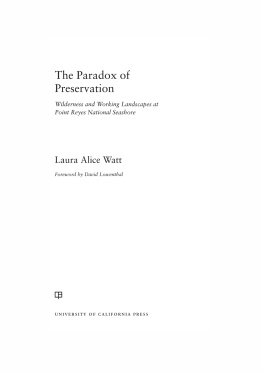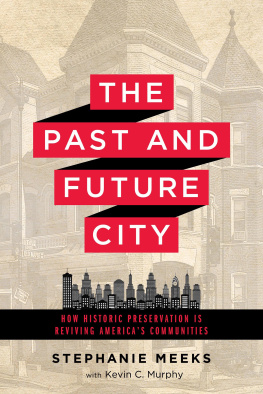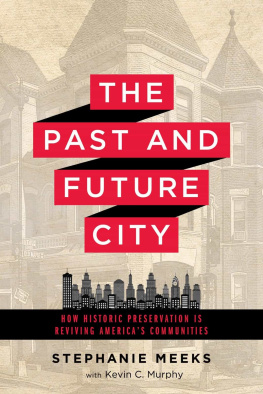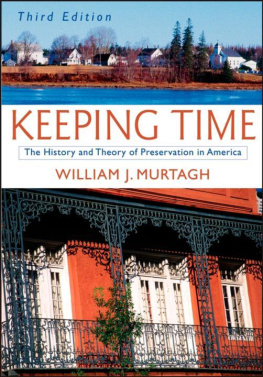why preservation matters
max page
why preservation matters

Why X Matters and the yX logo are registered trademarks of Yale University.
Copyright 2016 by Max Page.
All rights reserved.
This book may not be reproduced, in whole or in part, including illustrations, in any form (beyond that copying permitted by Sections 107 and 108 of the U.S. Copyright Law and except by reviewers for the public press), without written permission from the publishers.
Published with assistance from the Kingsley Trust Association Publication Fund established by the Scroll and Key Society of Yale College.
Yale University Press books may be purchased in quantity for educational, business, or promotional use. For information, please e-mail (U.K. office).
Set in Times Roman and Adobe Garamond types by Integrated Publishing Solutions.
Printed in the United States of America.
Library of Congress Control Number: 2016937786
ISBN 978-0-300-21858-9 (hardcover : alk. paper)
A catalogue record for this book is available from the British Library.
This paper meets the requirements of ANSI/NISO Z39.48-1992 (Permanence of Paper).
10 9 8 7 6 5 4 3 2 1
also by max page
The Creative Destruction of Manhattan, 19001940
The Citys End: Two Centuries of Fantasies, Fears, and Premonitions of New Yorks Destruction
Building the Nation: Americans Write About Their Architecture, Their Cities, and Their Environment (co-edited with Steven Conn)
Giving Preservation a History: Histories of Historic Preservation in the United States (co-edited with Randall Mason)
The Future of Higher Education (with Dan Clawson)
Reconsidering Jane Jacobs (co-edited with Tim Mennell)
Campus Guide to the University of Massachusetts (with Marla Miller)
Memories of Buenos Aires: Signs of State Terrorism in Argentina (editor)
Bending the Future: 50 Ideas for the Next 50 Years of Historic Preservation (co-edited with Marla Miller)
contents
preface
As the fiftieth anniversary of the 1966 National Historic Preservation Act approaches, it seems like an appropriate time to make an assessment of the effect that preservation policy and action have had on life in the United States, while also offering proposals for how preservation can be an even greater progressive force in the years to come. I also look beyond the boundaries of the United States, to places of historic importance around the world and the ways people are working to save them and tell their stories. I believe that just as the American movement on which I focus in this book can have relevance for people doing the work of building a progressive preservation movement in other countries, their work can have relevance for the U.S. preservation movementfor the values that I shall argue need to be part of the preservation movement of the future are human, not national values.
I wrote much of this book while on sabbatical in Medelln, Colombia, a place in which debates around preservation and memory have been particularly vital in recent years. Although I touch only briefly on those debates in my prologue, that swirl of discussion inevitably became background to my writing.
This book is the product of two decades of thinking about historic preservation, and has been anchored in experiences made possible by generous people and institutions.
Time to think, time to visit places, time to writethese are the greatest gifts to a scholar and writer. The University of Massachusetts, Amherst, and the College of Humanities and Fine Arts have been enormously supportive of my research and writing over the fifteen years I have been at the university. Six months at the American Academy as a Rome Prize Fellow in 2014 was a life-changing gift, allowing me to think about historic preservation in the company of brilliant, creative scholars and designers in a city that is an outdoor exhibition of preservation philosophies and techniques.
The Howard Foundation and the Marion Jasper Whiting Foundation offered me the chance to venture far beyond the United Statesto Argentina, Japan, Dubai, India, and Chinato explore how preservationists in other places wrestle with the question of what from the past should be brought into the future. In 2009, I was given the opportunity by the Fulbright Foundation to live and teach in Buenos Aires, in the midst of Argentinas confrontation with its violent past.
I was thrilled that Steve Wasserman was so passionate about having me write this volume for Yale University Press; he helped shape my approach from the start. Susan Laity was the outstanding manuscript editor I had been hoping for. Where the sentences flow, and logic follows, you will experience her mark on the book. I am humbled to be a part of the Why X Matters series, which features some of my intellectual heroes. I owe a continuing debt to Georges Borchardt for guiding me from book proposals to publications over the past decade. Special thanks as well to my friends Tom Mayes and Richard Rabinowitz for not only inspiring the ideas in the book through years of conversation and walks in cities but also reading a draft.
I grew up in a house filled with books and ideas; I live in that same house again with my own family. My parents, Anita and Alex Page, infused it with my first memories. Eve Weinbaum, who read and improved every paragraph in this book, created a new home in that place, with new layers of memory, for our children and for us.
why preservation matters
prologue
todos por la vidaeverything for life
Old images die hard. When Americans think of Medelln, Colombia, they immediately picture street battles between drug lords and the police, war-torn neighborhoods, and rampant crime. That image is two decades out of date. Today, Medelln is well into a renaissance, anchored by visionary ideas about how to make a city safe and vibrant. Soon after I arrived with my family, the government and the Revolutionary Armed Forces of Colombia (FARC), the largest of the guerrilla forces that have been party to the longest civil war in South America, finally reached agreement in Havana, Cuba. After fifty years, after hundreds of thousands of people lost their lives and millions were displaced (only with Syrias mass refugee crisis of 2015 did Colombia lose its dubious place at the top of the list of countries with the most internally displaced people), after a drug war that added layers of terror and destruction to the guerrilla war, Colombia may finally experience peace and a chance for rebuilding and eventual reconciliation. Part of this rebuilding will be the work of preservationists. Now is the time when memory could play a crucial role in solidifying Colombias new world, and contributing to reconciliation and social justice.
In fact, the process of reconciliation and rebuilding began in Medelln two decades ago, before the end of the war, with the death of the drug lord Pablo Escobar and the collapse of his cartel. This was Escobars city; from my apartment in the El Poblado neighborhood I could almost see his home, where he held much of the city in his tight, sometimes generous, always violent, grip. In the hills of Medelln was La Catedral, his private prison, from where he could look over his beloved birthplace, which had become, thanks to him, a war zone.
There has been precious little preservation as we usually define it in Medelln. The city has few individual buildings of great beauty; neither is there a fabric of older buildings that invite care. But Medelln has for two decades pursued a new kind of preservation, a brand of social urbanism with the motto Todos por la vida, everything for life, aiming to reconstitute public life by restoringId call it preservingits public spaces as necessary components of healthy, peaceful civic life. Successive mayors, pressed by citizens, have built a modern public transportation systemthe countrys only rail metro system is here, not in the capital of Bogotand a network of metro cables, gondolas that reach up into the steep, deeply poor and formerly violent neighborhoods. In one neighborhood, Comuna 13, elegant and safe outdoor escalators erase the isolation of thousands of residents in an area previously oppressed by drug trafficking. Across the city are two dozen new public libraries, sited at revived neighborhood hubs, accompanied by new parks, walkways, and bridges designed to knit together previously divided neighborhoods.
Next page






